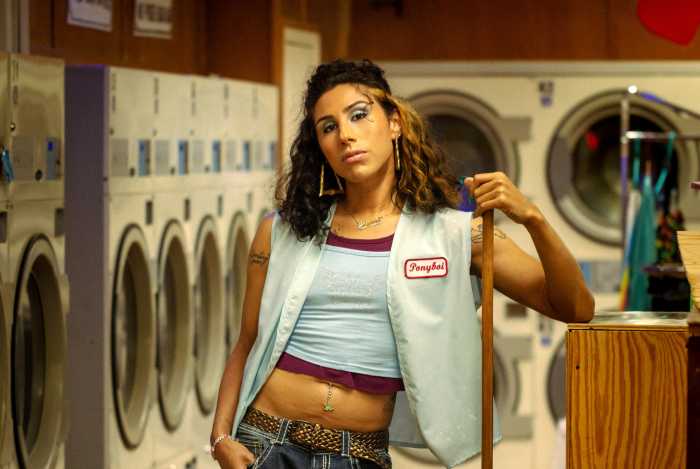Claire Foy in Steven Soderbergh’s “Unsane.” | FINGERPRINT RELEASING/ BLEECKER STREET
An experiment with contemporary technology steeped in an equally trendy suspicion of the modern world, Steven Soderbergh’s “Unsane” is the second feature-length film shot entirely on an iPhone, after Sean Baker’s great trans comedy-drama “Tangerine.”
At first, the cinematography seems slightly fuzzy and blurred, but one soon adjusts. However, the portability of smartphones led Soderbergh to choose many unusual camera angles and even deliberately break the rules of 180-degree sightline editing. There are simple shot/ reverse-shot sequences in “Unsane” that are suddenly disrupted by a cut to a completely new perspective or a view from the other side of the room. Soderbergh is a tech geek who long championed the high-definition RED camera before digital filmmaking became the norm. At a time when Christopher Nolan and Paul Thomas Anderson want their films to be shown on 70mm, “Unsane,” which lifted its title from the original, heavily edited American release of Dario Argento’s 1982 “Tenebrae,” is the equivalent of a heavily compressed MP3 file on cheap earbuds. I suspect Soderbergh thought its jumpiness was the perfect visual counterpoint to its paranoid narrative.
Stalking victim Sawyer Valentini (Claire Foy) has been forced to move from Boston to Pennsylvania, where she toils in a dull office job. Feeling down, she heads to the Highland Creek Behavioral Center for a counseling session. Without realizing it, she checks herself in for a 24-hour internment. She makes the acquaintance of Nate (Jay Pharoah), a friendly addict undergoing detox, and Violet (Juno Temple), an attitude-laden woman. But she thinks that staff member George Shaw (Joshua Leonard) really is her stalker. Panicking, she lashes out and winds up committed for an indefinite term.
With an iPhone, “Unsane” director has something to say about sharing a film experience with others
Soderbergh begins in some kind of recognizable reality. “Unsane” nods to America’s epidemic of opioid abuse and the failures of our health care industry. But in the end, these are just set-ups for a man to chase a woman. References to fentanyl, in this context, take topicality to the edge of exploitation. “Unsane” is essentially a B-movie that thinks it has more on its mind than it actually does. And like most stories of this type, it needs to spend an awful lot of time depicting a woman being victimized before it can celebrate her agency.
Warning: spoilers follow.
However, “Unsane” finally comes into its own in its final third. The film eventually boils itself down to its central concerns: a man and a woman confront each other in a room and she tries to make him realize how screwed-up his ideas about love and his behavior toward her are. The film at last conveys some truth about what it’s like to be stalked. (It contains little on-screen violence.) Its meat resonates beyond the genre context.
While these scenes’ impact relies on Soderbergh’s decisions about when and where to move the camera, as well as editing, they could probably be staged just as powerfully as theater. Their force stems mostly from the intensity of Foy and Leonard’s performances — he convincingly portrays a man with no idea how creepy he seems to others, although his ability to insinuate himself repeatedly into her life seems almost supernatural and works best as a symbol of male power — and the quality of screenwriters James Greer and Jonathan Bernstein’s dialogue.
Soderbergh’s last film, “Logan Lucky” (his return to the cinema after a brief “retirement” spent working in TV), had a $30 million budget raised from advances from Netflix and foreign distributors. “Unsane” was made for much less money, more like several million dollars. In the press kit, Soderbergh relates that there were only a dozen people on the set, apart from scenes that needed extras. But part of the reason he departed from working in mainstream American cinema — and then American cinema itself — is that his stamp as an auteur was yo-yoing between massive projects like “Oceans 11” and infinitely lower budget work like the bugfuck indie film “Schizopolis.”
My favorite Soderbergh films came during the period when it was possible to make medium-budget Hollywood fare that was smart and aimed at adults: “Out of Sight,” “Erin Brockovich,” and his remake of Andrei Tarkovsky’s “Solaris,” which was widely hated upon its 2002 release.
Those days are over, and our culture seems to have agreed that prestige TV — like Soderbergh’s Cinemax show “The Knick” — is now the place for such upper-middlebrow (if it’s possible to use that word without meaning it as an insult) work. The fact that Soderbergh grew dissatisfied working entirely for TV and still wanted a film shot on an iPhone to play movie theaters, even if its cinematography might ultimately look more attractive on a laptop, says something about the possibilities they still have for the communal experience of fright and identifying with a character’s sense of danger. “Unsane” may take two thirds of its length to communicate this with much force, but it gets there eventually, with enough power to demonstrate why it’s worth making the effort to see films theatrically instead of waiting for them to appear on Netflix.
UNSANE | Directed by Steven Soderbergh Fingerprint Releasing/Bleecker Street | Opens Mar. 23 in wide release



































